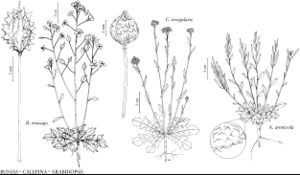Arabidopsis
in F. Holl and G. Heynhold, Fl. Sachsen 1: 538. 1842.
| Taxon | Illustrator ⠉ | |
|---|---|---|
 | Bunias erucago Calepina irregularis Arabidopsis arenicola | Yevonn Wilson-Ramsey Yevonn Wilson-Ramsey Yevonn Wilson-Ramsey |
Annuals, biennials, or perennials; (stoloniferous or with woody caudex); not scapose; glabrous or pubescent, trichomes simple, mixed with stalked, 1–3-forked ones. Stems erect, ascending, or decumbent, unbranched or branched distally, (usually glabrous distally). Leaves basal and cauline; petiolate, sessile, or subsessile; basal rosulate, petiolate, blade margins entire, toothed, or pinnately lobed; cauline blade margins usually entire or dentate, rarely lyrate. Racemes (few to several-flowered), not elongated in fruit. Fruiting pedicels ascending, divaricate, or slightly reflexed, slender. Flowers: sepals erect or ascending, usually oblong (or ovate), (lateral pair sometimes saccate or subsaccate basally); petals white, lavender, or purplish [pink, purple], obovate, spatulate, or oblanceolate, claw differentiated from blade or not, (apex obtuse or emarginate); stamens slightly tetradynamous; filaments not dilated basally; anthers oblong or ovate, (apex obtuse); nectar glands confluent, subtending bases of stamens. Fruits siliques, dehiscent, shortly stipitate or subsessile, linear, smooth or somewhat torulose, terete or latiseptate; valves (papery), each not veined or midvein prominent or obscure, glabrous; replum rounded; septum complete; ovules 15–80 per ovary; (style obsolete or distinct, to 1 mm); stigma capitate. Seeds usually uniseriate, plump or flattened, not winged or margined, oblong, ovoid, or ellipsoid; seed-coat (minutely reticulate), mucilaginous or not when wetted; cotyledons usually accumbent, rarely incumbent. x = 5, 8.
Distribution
North America, Europe, n, e Asia
Discussion
Species 10 (4 in the flora).
The limits of Arabidopsis have been the subject of long controversy, and more than 50 species were placed in the genus (I. A. Al-Shehbaz et al. 1999). The delimitation of the genus was based primarily on the presence of branched trichomes, linear fruits, and accumbent or incumbent cotyledons. That combination of characteristics evolved independently multiple times in Brassicaceae. Extensive molecular data and critical evaluation of morphology have shown that Arabidopsis is polyphyletic (S. L. O’Kane and Al-Shehbaz 2003). Nine of the ten species in the genus are native to Europe; only A. arenicola is endemic to North America.
Selected References
Key
| 1 | Annuals; petals 2-3.5(-4) mm; fruits 0.5-0.8 mm wide; seeds 0.3-0.5 mm. | Arabidopsis thaliana |
| 1 | Biennials or perennials; petals 4-10 mm; fruits 0.8-2.5 mm wide; seeds 0.8-1.4 mm | > 2 |
| 2 | Fruits terete or slightly flattened, (0.8-)1-2(-2.8) cm × 1.5-2.2(-2.5) mm; cotyledons incumbent. | Arabidopsis arenicola |
| 2 | Fruits flattened, (1.5-)2-4(-4.5) cm × 0.8-1.8(-2) mm; cotyledons accumbent | > 3 |
| 3 | Basal leaf blade margins pinnatisect or pinnatipartite; petals with 2 lateral teeth on claws. | Arabidopsis arenosa |
| 3 | Basal leaf blade margins entire, dentate, lyrate, or lyrate-pinnatifid; petals without teeth on claws. | Arabidopsis lyrata |
"not elongated" is not a number."thick" is not a number.